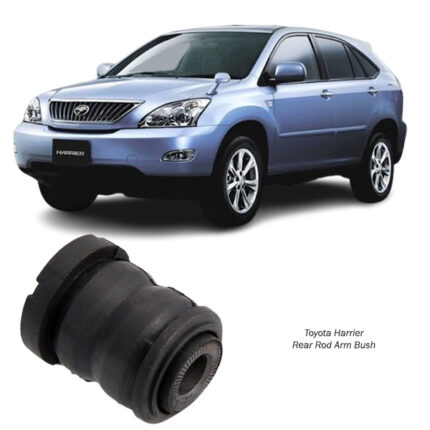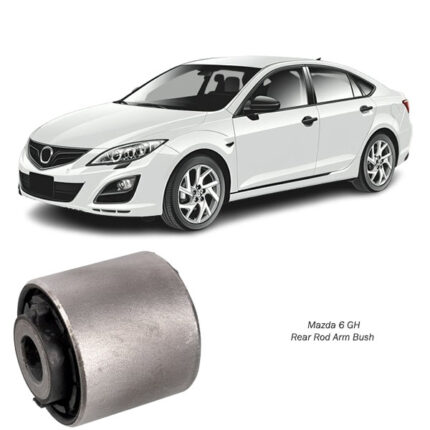-13%
Get Toyota Rush J200E Rear Stabilizer Bush
The stabilizer bushing, also known as the sway bar bushing or anti-roll bar bushing, is a critical component in a vehicle’s suspension system. It plays a crucial role in connecting the stabilizer bar (or sway bar) to the vehicle’s frame or chassis. Here’s a detailed look at the stabilizer bushing, including its functions, signs of wear or failure, and maintenance considerations:
Functions of Stabilizer Bushing
- Reducing Body Roll
- Primary Function: Minimize the body roll or sway of the vehicle during cornering.
- Details: The stabilizer bar connects the left and right wheels of the suspension. When the vehicle turns, the stabilizer bar twists, resisting the tendency of the vehicle to lean excessively. The stabilizer bushing holds the stabilizer bar in place, allowing it to perform its role effectively.
- Enhancing Stability and Handling
- Primary Function: Improve vehicle stability and handling.
- Details: By reducing body roll, the stabilizer bushing helps maintain better tire contact with the road surface during cornering, braking, and sudden maneuvers. This enhances overall stability and improves steering response.
- Absorbing Noise and Vibrations
- Primary Function: Dampen vibrations and noise from the suspension and road surfaces.
- Details: The stabilizer bushing, typically made of rubber or polyurethane, absorbs shocks and vibrations transmitted through the stabilizer bar. This contributes to a smoother and quieter ride for vehicle occupants.
- Maintaining Suspension Geometry
- Primary Function: Ensure proper alignment and geometry of the suspension system.
- Details: The stabilizer bushing holds the stabilizer bar securely in place, preventing excessive movement or misalignment. This helps maintain the correct suspension geometry, which is crucial for optimal vehicle performance and tire wear.
Signs of Worn or Failing Stabilizer Bushing
- Clunking or Rattling Noise
- Description: Audible noises, such as clunking or rattling, especially when driving over bumps or uneven surfaces.
- Details: Worn stabilizer bushings can allow the stabilizer bar to move excessively or make contact with other components, resulting in noise during vehicle operation.
- Increased Body Roll
- Description: Noticeable increase in vehicle body lean or sway during cornering.
- Details: If the stabilizer bushings are worn out, they may not effectively support the stabilizer bar, leading to reduced resistance to body roll and compromising vehicle stability.
- Poor Handling and Steering Response
- Description: Decreased responsiveness in steering, especially during sharp turns or maneuvers.
- Details: Failing stabilizer bushings can affect the alignment and movement of the stabilizer bar, resulting in compromised handling characteristics and steering response.
- Uneven Tire Wear
- Description: Abnormal wear patterns on the tires, such as uneven tread wear on the inner or outer edges.
- Details: Misalignment caused by worn stabilizer bushings can lead to uneven tire contact with the road, resulting in premature tire wear.
- Visible Damage
- Description: Cracks, tears, or deterioration in the rubber or polyurethane material of the bushings.
- Details: Visual inspection of the stabilizer bushings may reveal signs of wear, damage, or degradation, indicating the need for replacement.
Maintenance and Replacement
- Regular Inspection
- Routine Checks: Include stabilizer bushings in routine maintenance inspections, looking for signs of wear, damage, or deterioration.
- Professional Assessment: Have a mechanic inspect the bushings during regular servicing, especially if you notice any symptoms of failure.
- Timely Replacement
- Replace Worn Bushings: If any stabilizer bushings show signs of wear or damage, replace them promptly to prevent further issues.
- Quality Parts: Use high-quality OEM or reputable aftermarket bushings to ensure durability and proper fitment.
- Professional Installation
- Expert Service: Consider having a qualified mechanic perform the replacement, as it may require specialized tools and expertise to remove and install the bushings correctly.
- Alignment Check: After replacing stabilizer bushings, have a professional wheel alignment performed to ensure proper suspension geometry and handling.
Follow us on Facebook for more parts.



